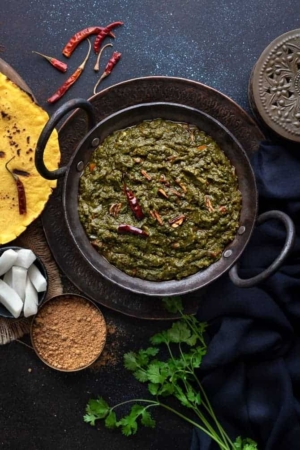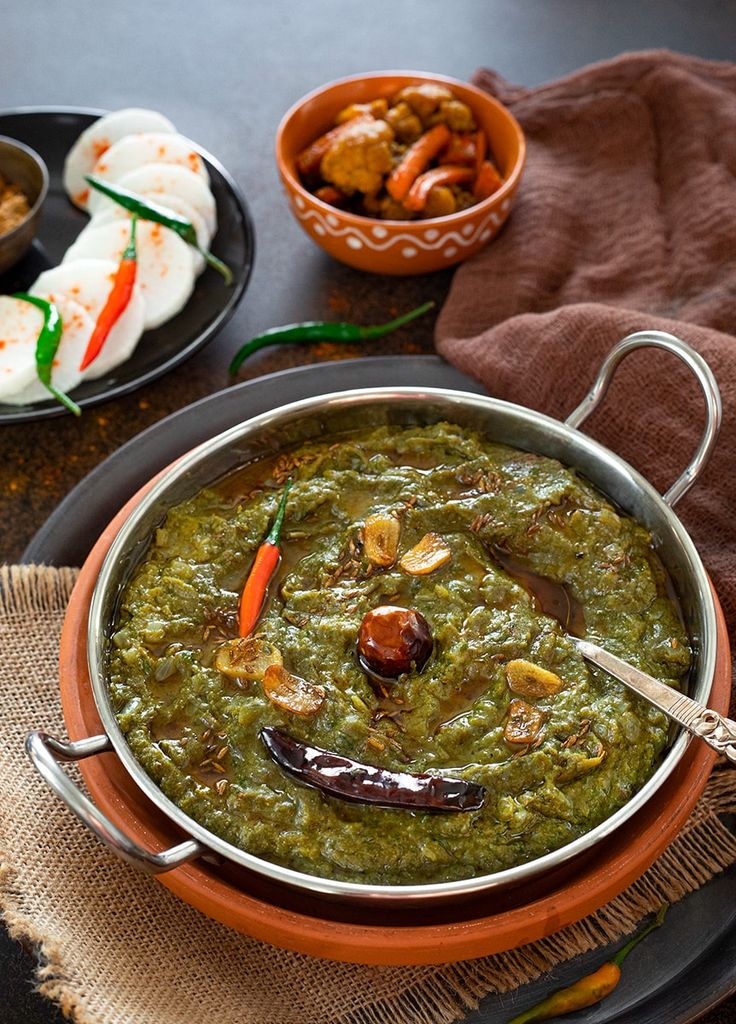Sarso ka saag is better than just a dish—it’s a festival of Punjabi origin, representing the warmth and richness of North Indian cuisine. Often paired with makki ki roti (cornmeal flatbread), this iconic winter treat is a perfect blend of loamy mustard greens and strong spices. The practice of sarso ka saag is a labor of love, embedded in traditional cooking methods that elevate simple ingredients into a soulful dish.
In this blog, we will guide you via an authentic recipe for sarso ka saag, explore its artistic significance, and share some tips to make it correctly every time.
Artistic Consequence of Sarso ka Saag
it holds a unique place in Punjabi families, especially during winter. The mustard greens, rich in iron and vitamins, are supposed to provide warmth and power during the cold months. Traditionally cooked on a slow flame in rural kitchens, the dish is a sign of society, often prepared in large amounts for family groups and festivals like Lohri and Maghi.
The acquisition of other greens like spinach (palak) and bathua (chenopodium) improves the flavor and healthy profile of sarso ka saag, making it a flat and healthy meal.
Components for Sarso ka Saag
To make accurate sarso ka saag, you’ll need the following ingredients:
For the Saag:
- Mustard greens (sarson) – 500 grams
- Spinach (palak) – 200 grams
- Bathua – 200 grams (optional but traditional)
- Radish (mooli) – 1 small, grated (optional)
- Green chilies – 2-3
- Ginger – 1-inch piece, chopped
- Garlic – 4-5 cloves
- Cornmeal (makki ka atta) – 2-3 tablespoons
For Tempering:
- Ghee – 2-3 tablespoons
- Onions – 1 medium, finely chopped
- Tomatoes – 2 medium, pureed
- Red chili powder – 1 teaspoon
- Asafoetida (hing) – a pinch
- Cumin seeds – 1 teaspoon
Step-by-Step Formula for Sarso ka Saag
Step 1: Cleaning and Organizing the Greens
- Wash the mustard greens, spinach, and bathua simply to remove dirt and grit.
- Dice the greens roughly, providing they are evenly sized for consistent cooking.
Step 2: Boiling the Greens
- In a big pot, boil the mustard greens, spinach, and bathua with 1-2 cups of water.
- Add grated radish, green chilies, ginger, and garlic. Haze and simmer for 30-40 minutes until the greens are delicate.
- Blend the cooked greens into a rough puree using a wooden whisk (madhani) or a blender. This consistency is key to authentic sarso ka saag.
Step 3: Thickening with Cornmeal
- Replace the blended greens to the jar and mix in the cornmeal to reduce the saag.
- Cook on low heat for another 15-20 minutes, stirring periodically to stop sticking.
Step 4: Designing the Tempering
The tempering (tadka) is what gives sarso ka saag its fragrant richness.
- Heat ghee in a pan and add cumin grains and a pinch of asafoetida.
- Once the seeds spray, add finely chopped onions and sauté until golden.
- Stir in the tomato puree, red chili powder, and cook until the mix releases oil.
Step 5: Connecting the Saag and Tempering
- Pour the prepared tempering into the boiled greens and mix well.
- Let the saag simmer for 5-10 minutes to allow the tastes to meld.
Filling Suggestions
Sarso ka saag is best appreciated with makki ki roti, a dollop of white butter (makkhan), and a side of holes. For an authentic Punjabi experience, do it with fresh jaggery (gur) and a drink of lassi.
Information for the Ideal Sarso ka Saag
- Slow Cooking is Key: Standard sarso ka saag requires patience. Slow cooking on a low flame improves its flavor.
- Cornmeal Ratio: Use just sufficient cornmeal to reduce the saag without conquering its taste.
- Balancing Greens: Mustard greens have a robust, slightly bitter flavor. Adding spinach and bathua helps balance the bitterness.
- Ghee for Authenticity: Using ghee rather than oil for tempering gives the saag a rich, aromatic finish.
- Seasonal Freshness: Still use fresh, seasonal greens for the best taste and food.

Why Sarso ka Saag is a Nutritional Powerhouse
it is not only delicious but also packed with fitness benefits:
- Rich in Iron and Calcium: Mustard greens are a wonderful source of iron, making the dish excellent for increasing hemoglobin levels.
- Loaded with Antioxidants: The greens are rich in vitamins A, C, and K, supporting impunity and skin health.
- High in Fiber: The dish stimulates digestion and gut health due to its fibrous surface.
Deviations to Try
While the classic recipe is timeless, here are some clever variations of sarso ka saag:
- With Methi (Fenugreek): Adding methi leaves presents a slightly bitter note that completes the sweetness of spinach.
- Smoked Saag: Infuse a smoky flavor by using charcoal dhungar after cooking.
- Creamy Saag: Stir in new cream for a richer, velvety surface.
Judgment
Sarso ka saag is not just a dish; it’s an image of tradition, warmth, and the spirit of togetherness that defines Indian cooking. Its essence lies in the rich mustard greens that are gathered in winter, making it a seasonal treat deeply rooted in the rural culture of Punjab. Beyond its culinary appeal, sarso ka saag elicits memories of chilly nights, wood-fired stoves, and family groups where food was not merely finished but celebrated.
This iconic dish transcends the boundaries of a simple recipe, offering a sensorial experience filled with rural flavors, earthy aromas, and the detailed richness of ghee. Whether it’s served in rural kitchens or urban homes, sarso ka saag has become synonymous with convenience food during the colder months. Pair it with makki ki roti (cornmeal flatbread) and a dollop of homemade butter, and you have a dinner that is both indulgent and nourishing.
The Artistic and Seasonal Force of Sarso Ka Saag
Sarso ka saag is more than a winter favorite; it’s a dish soaked in cultural heritage. In Punjab, winters are synonymous with the preparation of this hearty saag, especially during crop festivals like Lohri and Maghi. These festivals are a time to celebrate nature’s compensation, and sarso ka saag represents a relation to the land, symbolizing gratitude for the season’s harvest.
The practice of sarso ka saag is a labor-intensive method that has been passed down through years. It reflects a commitment to preserving traditions while creating something healthy and flavorful. Each family may have its own variation, but the love and effort coursed into making the dish remain constant.
A Nutritional Treasure Trove
it isn’t just delicious—it’s a powerhouse of nutrients that make it as beneficial as it is satisfying. Mustard greens, the star ingredient, are rich in:
- Iron: Helps combat anemia and boost power levels.
- Calcium: Essential for healthy bones and teeth.
- Vitamins A, C, and K: Support vision, exemption, and blood clotting.
- Dietary Fiber: Aids digestion and boosts gut health.
When mixed with spinach and bathua, the nutritional profile of the dish is further enhanced, making it a flat meal that can fortify the body against winter conditions.
The Art of Designing Sarso Ka Saag
Making sarso ka saag is a reflective process that demands patience and care. The greens are cleaned meticulously, boiled, and integrated into a coarse puree to retain their rustic texture. The addition of makki ka atta (cornmeal) not only reduces the saag but also lends it a distinct taste, balancing the slight irritation of the mustard greens.
The tempering—or tadka—is a crucial step that boosts the flavors. A mix of ghee, cumin, onions, and tomatoes forms the scented base, with a hint of red chili powder adding subtle heat. The final mix of the tempered spices with the cooked greens constructs a dish that is both complex and comforting.
A Meal That Gets People Jointly
it is traditionally served with makki ki roti, a flatbread made from cornmeal that pairs beautifully with the creamy saag. The meal is insufficient without a dollop of fresh white butter, which melts into the saag, adding an extra coating of richness. On the side, jaggery and pickled vegetables deliver a sweet and tangy contrast to the hearty flavors.
This combination is more than just a dinner for the taste buds—it’s a meal that encourages connection. In Punjabi households, training and sharing saag is often a communal activity, with family members coming together to donate to the process.
Why Sarso Ka Saag is Timeless
The continuing appeal of sarso ka saag lies in its power to strike a balance between nostalgia and nutrition. For many, it’s a dish that brings back fond recollections of childhood winters, where every bite was a reminder of familial love and practice. For others, it’s an introduction to the rich tapestry of Punjabi cuisine, offering a glimpse into its history and cultural consequences.
Whether you’re a novice cook testing Indian flavors or someone who cherishes the rules of Punjabi cooking, it is a dish that invites you to slow down and savor the moment. It’s a reminder that the most uncomplicated ingredients, when treated with care and respect, can create something extraordinary.
So, this winter, adopt the tradition, enjoy the flavors, and gather your loved ones to share the timeless comfort of saag. It’s not just a meal; it’s a carnival of life, love, and the rich culinary heritage of Punjab.
(All images only use for enterainment and knowledge purpose)







